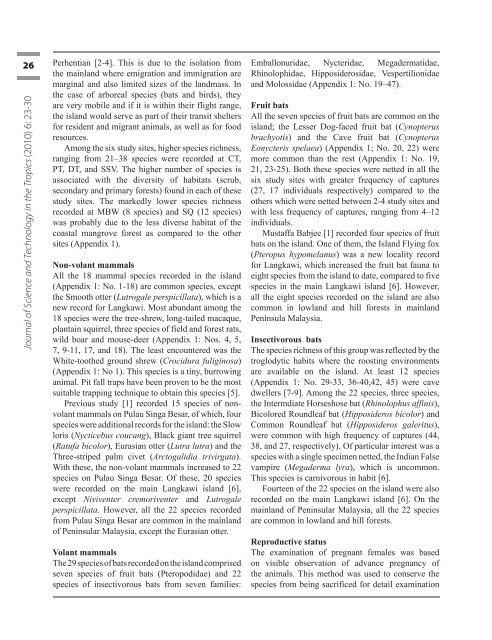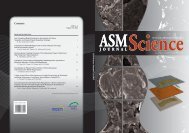Download - Akademi Sains Malaysia
Download - Akademi Sains Malaysia
Download - Akademi Sains Malaysia
You also want an ePaper? Increase the reach of your titles
YUMPU automatically turns print PDFs into web optimized ePapers that Google loves.
26<br />
Journal of Science and Technology in the Tropics (2010) 6: 23-30<br />
Perhentian [2-4]. This is due to the isolation from<br />
the mainland where emigration and immigration are<br />
marginal and also limited sizes of the landmass. In<br />
the case of arboreal species (bats and birds), they<br />
are very mobile and if it is within their flight range,<br />
the island would serve as part of their transit shelters<br />
for resident and migrant animals, as well as for food<br />
resources.<br />
Among the six study sites, higher species richness,<br />
ranging from 21–38 species were recorded at CT,<br />
PT, DT, and SSV. The higher number of species is<br />
associated with the diversity of habitats (scrub,<br />
secondary and primary forests) found in each of these<br />
study sites. The markedly lower species richness<br />
recorded at MBW (8 species) and SQ (12 species)<br />
was probably due to the less diverse habitat of the<br />
coastal mangrove forest as compared to the other<br />
sites (Appendix 1).<br />
Non-volant mammals<br />
All the 18 mammal species recorded in the island<br />
(Appendix 1: No. 1-18) are common species, except<br />
the Smooth otter (Lutrogale perspicillata), which is a<br />
new record for Langkawi. Most abundant among the<br />
18 species were the tree-shrew, long-tailed macaque,<br />
plantain squirrel, three species of field and forest rats,<br />
wild boar and mouse-deer (Appendix 1: Nos. 4, 5,<br />
7, 9-11, 17, and 18). The least encountered was the<br />
White-toothed ground shrew (Crocidura fuliginosa)<br />
(Appendix 1: No 1). This species is a tiny, burrowing<br />
animal. Pit fall traps have been proven to be the most<br />
suitable trapping technique to obtain this species [5].<br />
Previous study [1] recorded 15 species of nonvolant<br />
mammals on Pulau Singa Besar, of which, four<br />
species were additional records for the island: the Slow<br />
loris (Nycticebus coucang), Black giant tree squirrel<br />
(Ratufa bicolor), Eurasian otter (Lutra lutra) and the<br />
Three-striped palm civet (Arctogalidia trivirgata).<br />
With these, the non-volant mammals increased to 22<br />
species on Pulau Singa Besar. Of these, 20 species<br />
were recorded on the main Langkawi island [6],<br />
except Niviventer cremoriventer and Lutrogale<br />
perspicillata. However, all the 22 species recorded<br />
from Pulau Singa Besar are common in the mainland<br />
of Peninsular <strong>Malaysia</strong>, except the Eurasian otter.<br />
Volant mammals<br />
The 29 species of bats recorded on the island comprised<br />
seven species of fruit bats (Pteropodidae) and 22<br />
species of insectivorous bats from seven families:<br />
Emballonuridae, Nycteridae, Megadermatidae,<br />
Rhinolophidae, Hipposiderosidae, Vespertilionidae<br />
and Molossidae (Appendix 1: No. 19–47).<br />
Fruit bats<br />
All the seven species of fruit bats are common on the<br />
island; the Lesser Dog-faced fruit bat (Cynopterus<br />
brachyotis) and the Cave fruit bat (Cynopterus<br />
Eonycteris spelaea) (Appendix 1; No. 20, 22) were<br />
more common than the rest (Appendix 1: No. 19,<br />
21, 23-25). Both these species were netted in all the<br />
six study sites with greater frequency of captures<br />
(27, 17 individuals respectively) compared to the<br />
others which were netted between 2-4 study sites and<br />
with less frequency of captures, ranging from 4–12<br />
individuals.<br />
Mustaffa Babjee [1] recorded four species of fruit<br />
bats on the island. One of them, the Island Flying fox<br />
(Pteropus hypomelanus) was a new locality record<br />
for Langkawi, which increased the fruit bat fauna to<br />
eight species from the island to date, compared to five<br />
species in the main Langkawi island [6]. However,<br />
all the eight species recorded on the island are also<br />
common in lowland and hill forests in mainland<br />
Peninsula <strong>Malaysia</strong>.<br />
Insectivorous bats<br />
The species richness of this group was reflected by the<br />
troglodytic habits where the roosting environments<br />
are available on the island. At least 12 species<br />
(Appendix 1: No. 29-33, 36-40,42, 45) were cave<br />
dwellers [7-9]. Among the 22 species, three species,<br />
the Intermdiate Horseshose bat (Rhinolophus affinis),<br />
Bicolored Roundleaf bat (Hipposideros bicolor) and<br />
Common Roundleaf bat (Hipposideros galeritus),<br />
were common with high frequency of captures (44,<br />
38, and 27, respectively). Of particular interest was a<br />
species with a single specimen netted, the Indian False<br />
vampire (Megaderma lyra), which is uncommon.<br />
This species is carnivorous in habit [6].<br />
Fourteen of the 22 species on the island were also<br />
recorded on the main Langkawi island [6]. On the<br />
mainland of Peninsular <strong>Malaysia</strong>, all the 22 species<br />
are common in lowland and hill forests.<br />
Reproductive status<br />
The examination of pregnant females was based<br />
on visible observation of advance pregnancy of<br />
the animals. This method was used to conserve the<br />
species from being sacrificed for detail examination<br />
Jostt vol 6.indd 26 7/22/10 10:09:03 PM

















